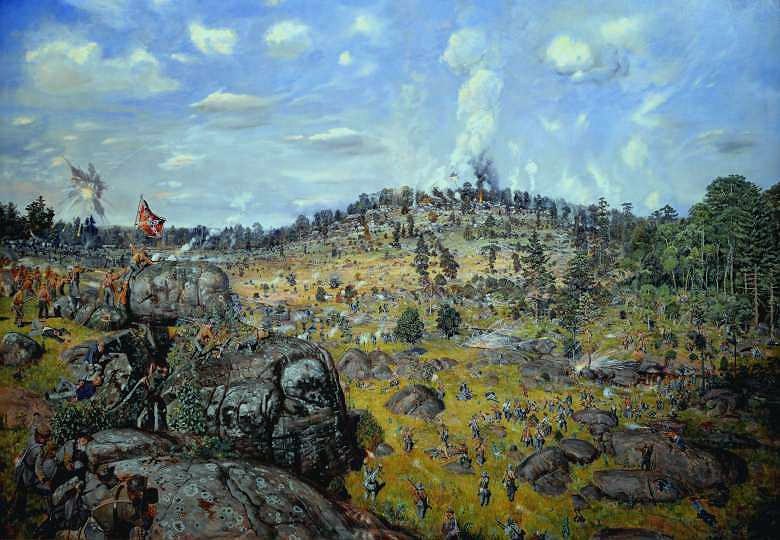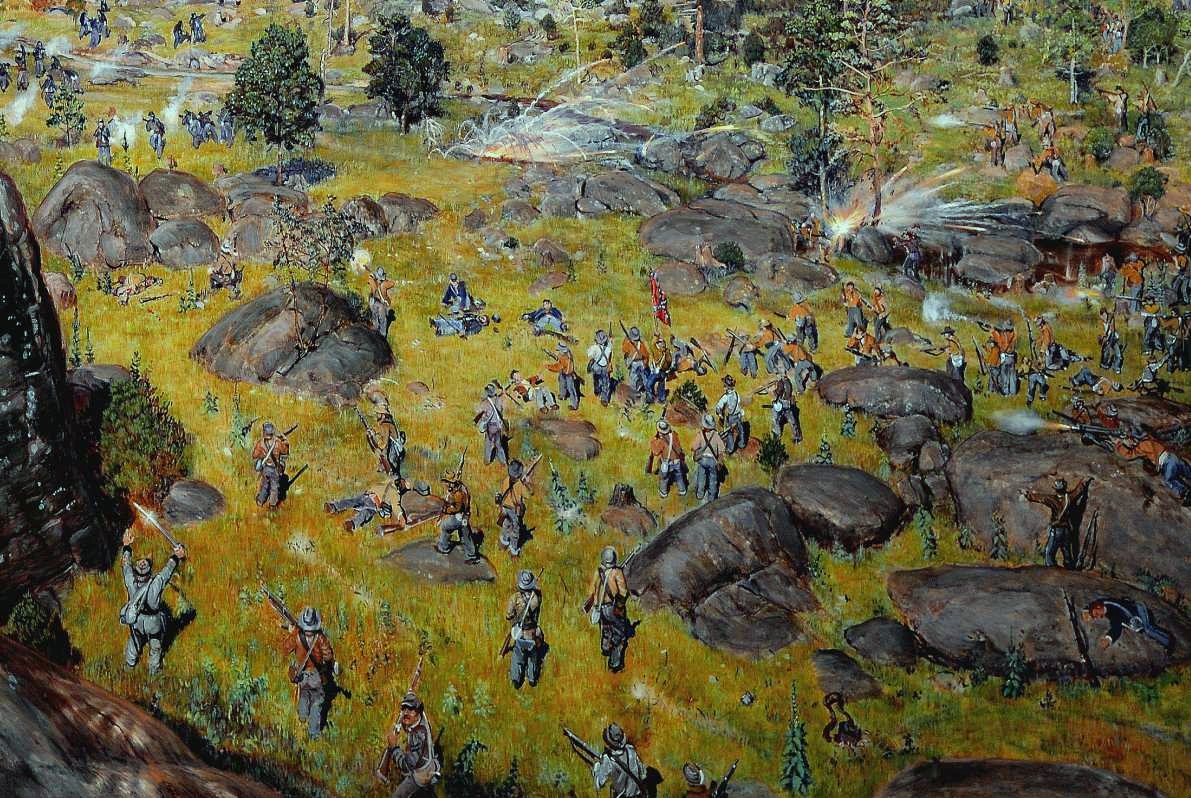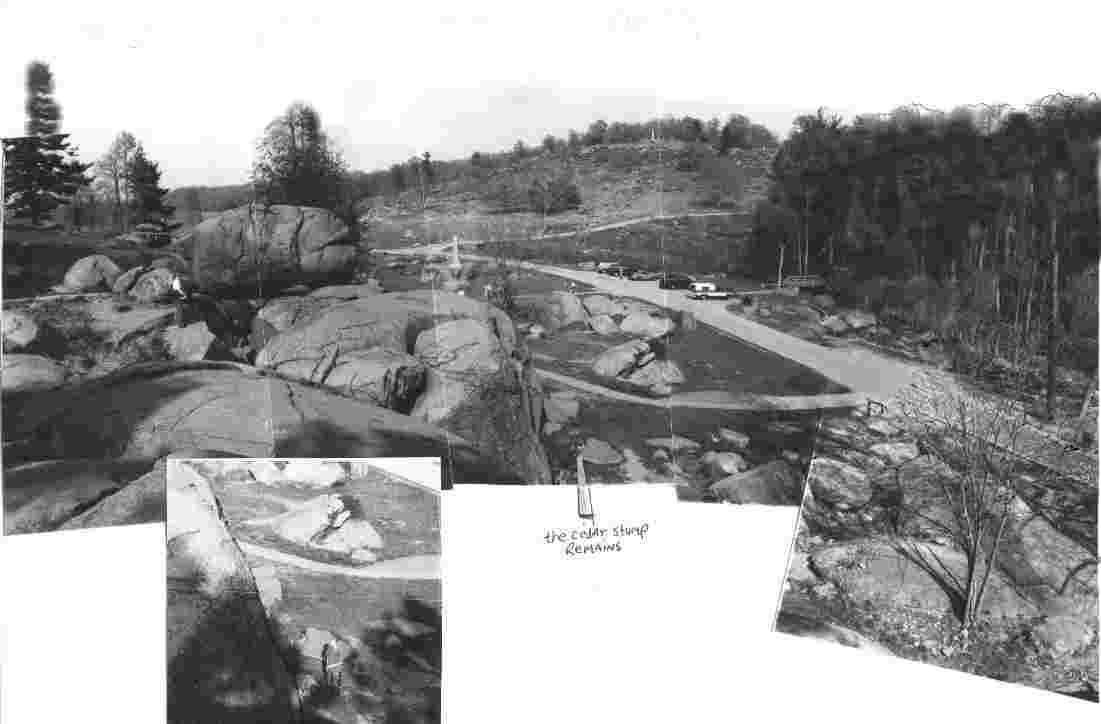

Captain Smith's Cannon
Devil's Den, Slaughter Pen, Valley of Death and Little Round Top
5 o'clock July 2nd 1863

Compressed detail from lower right of painting
We offer a limited edition of 2000 artist's signed lithographs of this historically accurate oil painting. This print has an image-size measuring 15x24 inches, with large margins. The price for each signed and numbered print: is $90.00 plus $10.00 shipping in 4-inch heavy tube (total $100.00). Maryland residents will be charged 6% sales tax. Description
This battlefield reconstruction is exhaustively based on photography recorded just after the
battle at Gettysburg, which ended July 3, 1863. Every attempt has been made to put every discernible mullein plant and granite boulder (as well as its moss and lichen) in its historically proper place. Comparisons of modern and historical photography shows that little has changed in the Gettysburg battle area. Trees and shrubs come and go but granite stays.
Mr. Groves has chosen the most popular overlook for his "battlescape", the "Duck Rock" (called by the Park "Table Rock") of the Devil's Den area. (When viewed from the parking area these rocks resemble a duck
decoy. The viewer hovers 10 feet above and behind the "duck's" back.) The scene is full of
battlefield minutia. "Armed" with officers battle reports and the historic photos, the artist has
made every effort to present to the viewer an accurate visual analyzation.
Description: In the distance, right, Little Round Top seems to "erupt" as 3 union cannons fire
away at attacking confederates moving up Houck's ridge (left side of painting). Rebel infantry of
the 4th and 5th Texas and 15th Alabama regiments attempt to reach the summit on the open
south side of the rocky hill, while the 48th, 47th and 15th Alabama regiments attempt to take the
wooded side (smoke rising through trees). None will succeed.
In the lower left foreground, remnants of the 44th Alabama regiment have successfully grabbed
the southern (Devil's Den) terminus of Houck's ridge. 3 of Union Captain James Smith's 4th
New York Battery cannon have been captured (not visible but situated just 50 yards to left of
Duck rock). Smith has retreated 500 feet to the rear and has commenced firing two final cannon
(smoke above the duck's head) at confederates of the 2nd Georgia advancing up the Plum Run
Gorge (right and center fore ground). This gorge would become known as the "slaughter Pen"
either owing to the numerous cattle or confederates killed within the area that day.
Various probable and actual enactments take place throughout the painting: Above and left of
the duck's head a 10 pounder case shot, fired from one of the Little Round Top parrotts, bursts
with a deadly scattering effect. In the left foreground an exhausted Col. William Perry (CSA
44th Alabama) directs his major to pull the men back to the cover of the cliffs. Perry's lieutenant
points out Smith's cannon and assembling Union reinforcements. The battle for Houck's ridge is
winding down as what's left of the 4th Maine, 124th New York, and the 99th Pennsylvania lose
and gain repeatedly. Lt. Col. William Shepherd, 2nd Georgia, with sabre reflecting the late
afternoon sunlight, attempts to anchor his line with the position of the southern troops atop the
Den. One of Capt. Smith's cannon shells nearly causes a friendly fire incident as a 2nd shell
knocks a locust tree from its stump and severs the right leg of a luckless Georgian. The same
shell probably accounts for most of the dead confederates photographed Sunday at the Plum Run
Pond area. Col. Elijah Walker, of the 4th Maine, (fired upon by prone shooter atop the duck's
shoulder) implores his men to clear the gorge so that Smith's cannon can sweep the approaching
Georgians.
A Union cannoneer, gravely wounded has been dragged to relative safety as 3 rebels help to
make their flag dominate the "Den" area. Within the center valley the 6th New Jersey
volunteers (not visible-behind duck's head) and the 40th New York (right center) are forming a
line to drive down the valley in an(unsuccessful) attempt to push back the rebel line.
Click here for a summary report on the painting. A composite view from Devil's Den, Spring 1996
